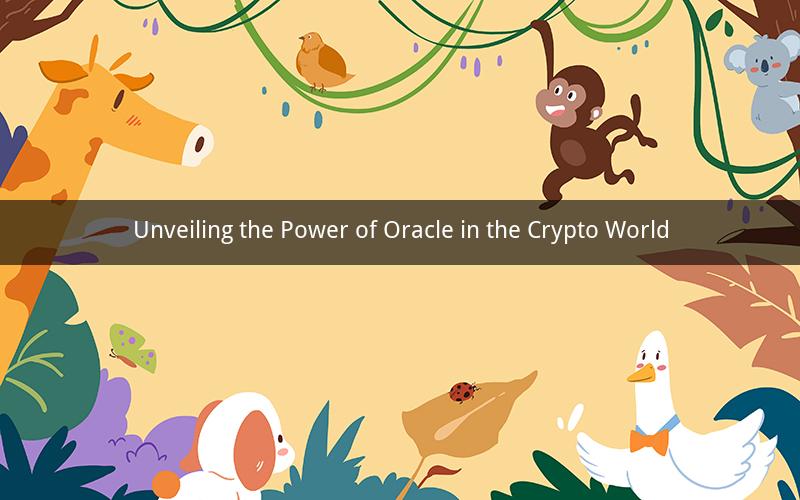
In the rapidly evolving landscape of cryptocurrencies, the role of oracles has become increasingly significant. But what exactly is an oracle in crypto? This article delves into the concept, its importance, and how it functions within the blockchain ecosystem.
Understanding Oracles in Crypto
An oracle in the context of cryptocurrencies is an intermediary that connects the blockchain with real-world data. While blockchain technology is excellent for recording transactions and maintaining a decentralized ledger, it lacks the ability to interact with external data sources. This is where oracles come into play.
Oracles act as a bridge, allowing smart contracts to access and process real-world data, such as stock prices, weather conditions, or even election results. By doing so, they enable decentralized applications (DApps) to perform complex tasks and make informed decisions based on real-world events.
The Importance of Oracles in Crypto
The importance of oracles in the crypto world cannot be overstated. Here are some key reasons why oracles are crucial for the growth and development of the blockchain ecosystem:
1. Enabling Smart Contracts: Smart contracts are self-executing contracts with the terms of the agreement directly written into lines of code. Oracles provide the necessary data for these contracts to function, allowing them to trigger actions based on real-world events.
2. Expanding Use Cases: By providing access to real-world data, oracles enable a wide range of applications, from decentralized finance (DeFi) to supply chain management. This expands the potential use cases for blockchain technology and attracts more users and developers to the ecosystem.
3. Enhancing Security: Oracles can help improve the security of blockchain networks by providing reliable and verifiable data. This reduces the risk of smart contracts being manipulated or exploited.
How Oracles Function in Crypto
Oracles function by collecting data from various sources and delivering it to the blockchain. Here's a simplified overview of how the process works:
1. Data Collection: Oracles gather data from various sources, such as APIs, sensors, or even human input. These sources can range from financial market data to weather conditions and more.
2. Data Verification: Once the data is collected, it must be verified to ensure its accuracy and reliability. This is done through a process called consensus, where multiple nodes in the network agree on the validity of the data.
3. Data Delivery: After the data is verified, it is delivered to the blockchain. This can be done through a variety of methods, such as off-chain oracles or on-chain oracles.
Types of Oracles in Crypto
There are several types of oracles, each with its unique characteristics and use cases:
1. On-Chain Oracles: These oracles store data directly on the blockchain, making it easily accessible and verifiable. However, they can be expensive and slow to process data.
2. Off-Chain Oracles: Off-chain oracles store data off the blockchain, reducing costs and increasing processing speed. However, they can be more susceptible to manipulation and less transparent.
3. Third-Party Oracles: These oracles rely on third-party providers to collect and verify data. This can provide a higher level of trust and security but may come with additional costs.
Challenges and Future of Oracles in Crypto
While oracles have the potential to revolutionize the crypto world, they also face several challenges:
1. Data Integrity: Ensuring the integrity of the data collected and delivered by oracles is crucial. Manipulated or incorrect data can lead to faulty smart contracts and loss of trust in the blockchain ecosystem.
2. Scalability: As the number of DApps and smart contracts increases, the demand for oracles also grows. Scalability is a significant challenge, as it can affect the overall performance of the blockchain network.
3. Security: Oracles must be secure to prevent malicious actors from tampering with the data. This requires continuous monitoring and updates to address potential vulnerabilities.
Despite these challenges, the future of oracles in crypto looks promising. As the technology evolves and more solutions are developed, oracles will become an integral part of the blockchain ecosystem, enabling a wide range of innovative applications.
Frequently Asked Questions (FAQs)
1. What is the primary purpose of an oracle in crypto?
An oracle's primary purpose is to connect the blockchain with real-world data, enabling smart contracts to interact with external information.
2. How do oracles ensure the accuracy of the data they provide?
Oracles use a consensus mechanism to verify the accuracy of the data. This involves multiple nodes in the network agreeing on the validity of the data.
3. Can oracles be used in any industry other than cryptocurrencies?
Yes, oracles have the potential to be used in various industries, including finance, healthcare, and supply chain management.
4. What are the main types of oracles available in the crypto world?
The main types of oracles are on-chain, off-chain, and third-party oracles.
5. How do oracles contribute to the security of blockchain networks?
Oracles contribute to the security of blockchain networks by providing reliable and verifiable data, reducing the risk of smart contracts being manipulated or exploited.